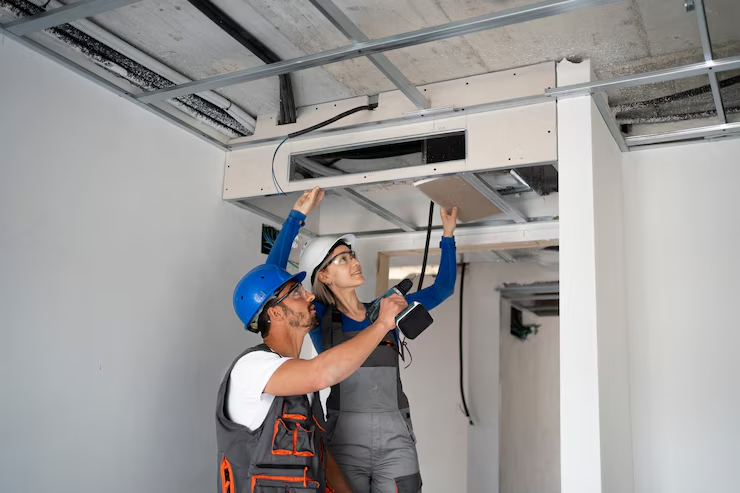Wall Vent Covers are an essential part of your home’s HVAC system. They help ensure that conditioned air reaches your living spaces, maintaining a comfortable temperature throughout your home. Whether you’re choosing decorative vent covers or simply looking for a functional option, it’s important to understand how they interact with your HVAC system.
While decorative air vent covers can complement your home’s style, they can sometimes affect the airflow and overall efficiency of your HVAC system. The size, style, and placement of your wall vent covers can make a difference in how well your system performs. Let’s take a closer look at how these covers influence your air circulation and what you should consider before making a choice.
What Are Wall Vent Covers and Why Do They Matter?
Wall vent covers are essential components in your home’s heating, ventilation, and air conditioning (HVAC) system. They are placed over vents in your walls and help direct the flow of air in and out of the system. These covers ensure that air is distributed properly throughout your home, keeping rooms at the right temperature.
While vent covers might seem like a minor feature, they play an important role in improving the comfort of your living space. Without them, your system could struggle to maintain the right temperature or circulate air evenly, leading to inefficiency.
These covers come in various materials, sizes, and designs, so you can choose one that matches your home’s style. Whether you prefer sleek metal covers or decorative wooden ones, choosing the right cover ensures better airflow and a more pleasant living environment.
How Wall Vent Covers Impact Your HVAC System’s Efficiency
Wall vent covers have a significant effect on how well your HVAC system works. If your vent covers are clogged with dust or poorly fitted, air can’t flow freely. This can make your system work harder, using more energy to heat or cool your home.
To keep your HVAC system efficient, make sure your vent covers are clean and properly installed. A cover that’s too small or too large for the vent can block airflow and reduce your system’s ability to reach the desired temperature. Regular maintenance and occasional cleaning of your vent covers will also help your HVAC system run smoothly.
When selecting wall vent covers, it’s important to ensure they fit correctly with your system’s specifications. A well-fitting cover enhances airflow and energy efficiency, keeping your system running at its best.
Decorative vs. Functional Wall Vent Covers: Which is Better for Your HVAC?
Decorative wall vent covers can add a stylish touch to your home, but it’s important to balance looks with functionality. While they might improve the appearance of a room, choosing the wrong type could negatively impact your HVAC system’s performance.
If you want to enhance your home’s decor, make sure that the design doesn’t interfere with the airflow. Decorative vent covers should allow air to flow freely while adding beauty to the space. Choosing functional vent covers that still look good is the key to achieving both style and efficiency.
When picking the right vent cover, consider the material and design. For instance, a metal cover might look sleek but could block airflow if it’s designed poorly. On the other hand, a well-designed wooden cover can improve your home’s look without sacrificing performance.
Tips for Choosing the Right Decorative or Functional Vent Covers:
- Make sure the cover fits the vent properly.
- Look for designs that allow for optimal airflow.
- Consider the material: wood, metal, and plastic are common choices.
- Ensure that the cover can be cleaned easily to maintain efficiency.
Choosing the Right Size for Wall Vent Covers to Optimize Airflow

Choosing the right size for wall vent covers is one of the most important factors in maintaining HVAC efficiency. If the vent cover is too large, it can block air from circulating properly. On the other hand, a cover that’s too small may not provide the necessary coverage for your vent, causing energy loss.
Before purchasing a vent cover, measure the size of your vent. This will ensure you get the right fit for optimal airflow. It’s also essential to ensure that the cover is secure, as a loose cover can cause air leakage, further reducing the system’s efficiency.
You can find vent covers in different sizes and shapes to suit your home’s needs. If you are unsure about the right size, consulting an HVAC professional can help ensure you make the best choice for your system.
Can Wall Vent Covers Improve the Look of Your Home Without Affecting HVAC Performance?
Yes! Wall vent covers can be both functional and stylish, improving your home’s appearance while maintaining the efficiency of your HVAC system. When choosing a cover, you don’t have to compromise on looks for the sake of performance.
Decorative vent covers are available in a variety of materials, colors, and designs, allowing you to find one that complements your room’s decor. Whether you prefer a classic look or something more modern, there’s a vent cover that fits your needs.
However, it’s important to ensure that the decorative design doesn’t interfere with the air circulation. If airflow is blocked, your HVAC system will have to work harder, which can lead to higher energy bills. So, make sure your chosen design is both attractive and functional.
How to Maintain the Balance:
- Choose vent covers with breathable materials like metal or wood.
- Regularly clean your vent covers to avoid dust buildup.
- Pick a design that allows for unobstructed airflow.
Understanding Air Circulation: How Wall Vent Covers Influence Temperature Control
Air circulation plays a crucial role in maintaining the comfort of your home. Wall vent covers help control this airflow by directing air where it’s needed most. A well-placed cover allows air to circulate freely, maintaining a stable temperature throughout your rooms.
Without proper airflow, your HVAC system might struggle to reach the desired temperature, causing some rooms to feel warmer or colder than others. Choosing the right cover that supports air movement can help your system work efficiently and keep your home comfortable.
Key Points for Better Airflow:
- Keep vents clear of obstacles to ensure smooth airflow.
- Choose vent covers that don’t block the air passage.
- Make sure the cover is the correct size to avoid restricting airflow.
Avoiding Common Mistakes When Installing Wall Vent Covers
Installing wall vent covers may seem like a simple task, but there are common mistakes that can affect the efficiency of your HVAC system. One of the biggest errors is choosing the wrong size or type of cover. If the cover doesn’t fit properly, it could block airflow and force your HVAC system to work harder than necessary.
Another mistake people make is not cleaning their vent covers regularly. Dust and debris can accumulate, blocking the flow of air, which will reduce the overall performance of the system. Always clean your vent covers to ensure they are functioning at their best.
It’s also essential to check that the vent covers are securely fastened. A loose cover may cause air to leak out, making your system less efficient. Proper installation and regular maintenance are key to keeping your HVAC system running smoothly.
Why Airflow Matters: The Role of Wall Vent Covers in Your HVAC System

Airflow is critical to the performance of your wall vent covers and the entire HVAC system. If air is not flowing efficiently through your vents, your HVAC system will have to work harder to heat or cool your home, which can result in higher energy bills.
A well-placed vent cover helps air move smoothly through the system, ensuring that each room gets the proper amount of heated or cooled air. If your vent covers are blocked or improperly sized, the airflow will be restricted, and the system will struggle to maintain your desired temperature.
Properly maintaining your vent covers is essential for airflow. Cleaning and adjusting them as needed can help prevent airflow blockages that negatively impact HVAC performance.
Tips to Improve Airflow:
- Install vent covers that allow air to flow freely.
- Clean vent covers regularly to avoid dust buildup.
- Ensure vents are not obstructed by furniture or other items.
Conclusion
In conclusion, wall vent covers are important for both the style and efficiency of your home’s HVAC system. They help keep air flowing properly throughout your home, ensuring that your heating and cooling system works efficiently. Whether you choose decorative covers or functional ones, it’s crucial to pick the right size and material to maintain airflow and avoid any system problems.
Taking the time to clean and maintain your vent covers can also make a big difference in how well your HVAC system runs. With the right care, your vent covers can help keep your home comfortable, stylish, and energy-efficient. So, when choosing and installing them, always consider both their look and function to get the best results for your home.
FAQs
Q: What are wall vent covers?
A: Wall vent covers are placed over vents in your walls to help direct airflow in and out of your HVAC system. They come in various sizes and designs, both decorative and functional.
Q: Do decorative wall vent covers affect airflow?
A: Decorative vent covers can still allow air to flow if they are designed properly. However, it’s important to choose a cover that doesn’t block airflow to maintain your HVAC system’s efficiency.
Q: How often should I clean my wall vent covers?
A: It’s a good idea to clean your vent covers every 2 to 3 months to prevent dust and debris buildup. This will help your HVAC system run more efficiently.
Q: Can wall vent covers save me money on energy bills?
A: Yes, if the vent covers are correctly sized and installed, they can help improve airflow and make your HVAC system more efficient, potentially lowering your energy costs.
Q: Are there different types of wall vent covers?
A: Yes, wall vent covers come in many materials like metal, wood, and plastic. They also come in different styles, from simple and functional to decorative designs that match your home’s decor.